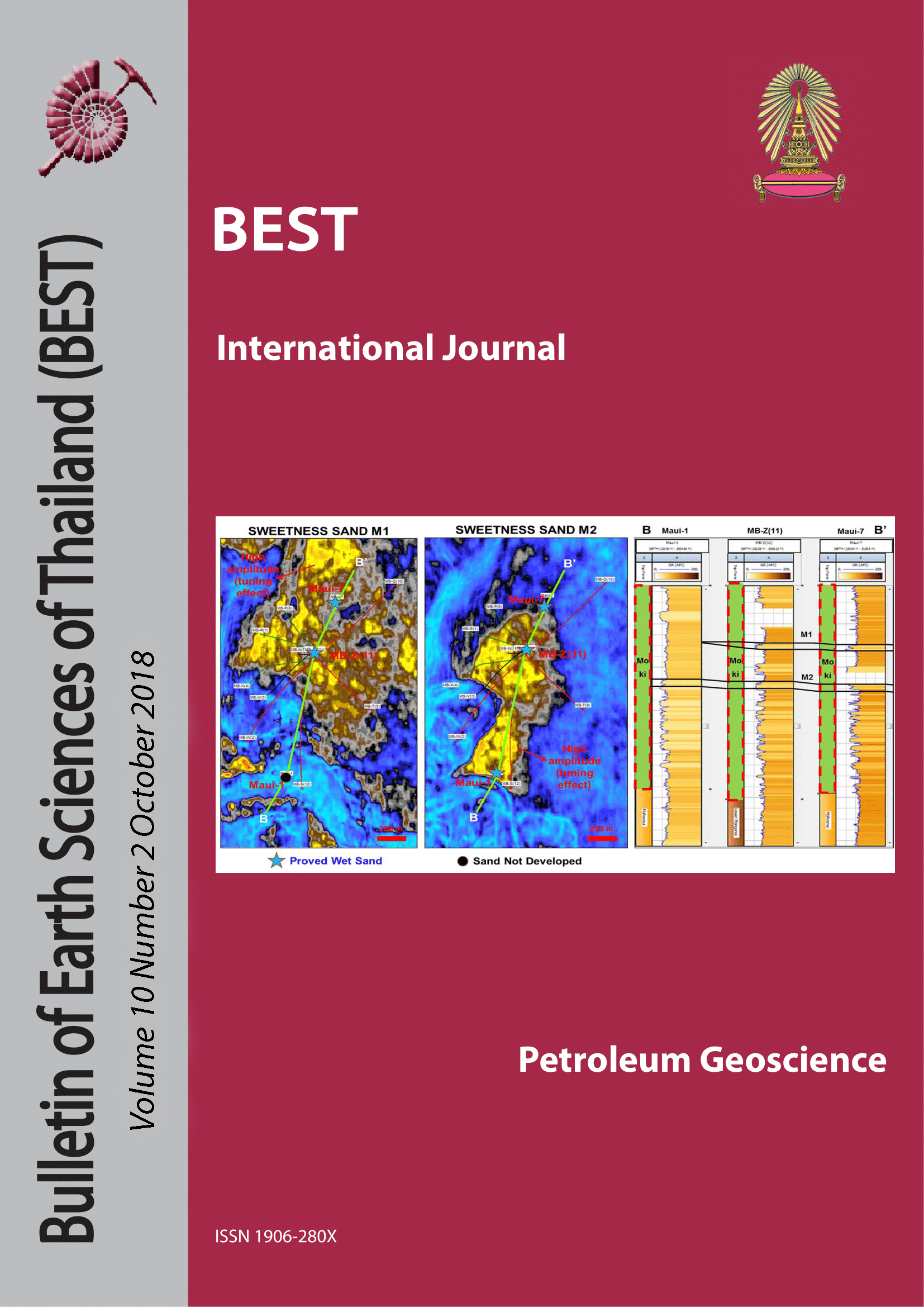Fracture Analogue Modeling and Fluid Evolution, Central Thailand: A Tectonically Driven Fluid System
Main Article Content
Abstract
The ultimate aim of this study is to develop better relevant local diagenetic analogs for the fluid and structural evolution system that created the economic porosity in producing carbonate reservoirs in the subsurface of northeast and southern Thailand. This is done using field observations tied to detailed petrographic and stable isotope determinations focused on exposures in a quarry in Nakhon Sawan Province, central Thailand. There outcrop studies show the folds and thrusts in the Permian limestone underwent complex deformation related to the Indosinian Orogeny (Late Permian to Early Triassic) and that some fractures within this structural grain were reactivated during Cenozoic time. The deformation history evolved mainly under the influence of (approximately) NNE – SSW directed compression. The largest thrust faults in the study area trend SE-NW, and dip 30° – 40°. Fault bend fold and duplex structures are also present. Two types of fractures are present: parallel to sub-parallel of bedding and inclined or sub-vertical of bedding. Fracture sets can be grouped into two main categories: a) Bedding-parallel fractures with WNW– ESE trend, and b) inclined or sub-vertical fractures with bedding showing a NNE– SSW trend. These fractures progressively developed during folding and thrusting in the core zone of the deformation. The high-angle fractures in the fault zone are truncated by a late stage subhorizontal pressure solution cleav-age, which probably developed during loading by a now eroded higher thrust sheet. Stable oxygen and carbon isotope signatures in calcite veins indicate that they are related to and evolv-ing tectonic history. Group I defines a C-O plot field that indicates lower burial temperatures, it is considered to reflect a cooler, likely earlier, part of the mesogenetic burial trend. Group I is especially apparent in the matrix across the quarry and is also associated with the development of widespread early fractures and stylolites. Group II is interpreted as a late burial stage calcites precipitated in what was a hotter and perhaps deeper sub-surface environment. Group III is an intermediate set of C-O values possibly derived during mixing of deeply circulating meteoric fluids in the early stages of telogenetic uplift. The bicarbonate in the pore fluids precipitat-ing Group III calcites is strongly influenced by dissolution of rock material in a deep stagnant phreatic zone. Recent speleothem samples give slightly variable oxygen numbers in an uplift trend with consistently more negative carbon values than Group III, and so defines the isotope cluster that is Group IV. Group IV samples come from zones of carbonate soil in karst, speleothems and slickensides calcites. The Group IV plot field de-fines a mixing trend where the CO2 and consequent bicarbonate in the precipitated calcites are strongly fluid influenced during fluid-rock interactions in the zones of active phreatic and vadose circulation. Much of its negative carbon signature indicates precipitation from rainwaters that have moved through zones of soil gas, that is, flow in the upper meteoric carapace to the uplifted sediments....
Article Details

This work is licensed under a Creative Commons Attribution-NonCommercial-NoDerivatives 4.0 International License.
Copyright © 2008 Department of Geology, Faculty of Science, Chulalongkorn University. Parts of an article can be photocopied or reproduced without prior written permission from the author(s), but due acknowledgments should be stated or cited accordingly.
References
Ampaiwan, P., 2011. Structural Development of Thrusts, Folds and Fractures in Quarry Expo-sures of Permian Limestones, Saraburi Province, Cen-tral Thailand: Implications for Fractured Re-ser-voir Development in NE Thailand. Chula-longkorn University, Bangkok, p. 44 (M.Sc thesis).
Booth, J., and N. Sattayarak, 2011, Subsurface Car bonierous - Cretaceous Geology of NE Thai-and. In: Ridd, M.F., Barber, A.J. & Crown, M.J.(eds), The Geology of Thailand, The Geolog-ical Society of London, p.185222.
Charusiri P., Clark A. H., Farrar E. & Archibald D. 1999. Note on the 40Ar/39Ar dating results of the volcanic rocks of central Thailand. Journal of Asian Earth Sciences.
Embry, A.F., Klovan, J.E. (1972): A late Devonian reef tract on northeastern Banks Island. N.W.T. – Bull.Canadian Petrol. Geol., 19, 730-781
Morley, C.K., Ampaiwan, P., Thanudamrong, S., Kuenphan, N., Warren, J., 2013. Development of the Khwang Fold and Thrust Belt: implications for the geodynamic setting of Thailand and Cambodia during the Indosinian Oroge-ny. J. Asian Earth Sci. 62, 705-719.
Nelson, C. S., and A. M. Smith, 1996, Stable oxygen and carbon isotope compositional fields for skeletal and diagenetic components in New Zealand Cenozoic nontropical car-bonate sediments and limestones: a synthesis and review: New Zea-land Journal of Ge-ology and Geophysics, v. 39, p. 93-107.
Panthong, A., 2015, Facies distribution and diagenetic evolution of carbonate reservoir in Pha Nok Khao Formation, Sinphuhorm field, Thailand.Chulalongkorn University, Bangkok, p. 39 (M.Sc thesis).
Pomer, L., Gili, Bradano, M. and Westphal, H. (2004) Environmental factors influencing skeletal grain sediment associations: A critical review of Miocene examples from the Western Mediterranean. Sedimentology. 51, 627-651.
Racey, A., 2011. Petroleum geology. In: Ridd, M.F., Barber,A.J. Crow, M.J. (eds.), The Geology of Thailand, The Geological Society of London, pp. 351–392.
Sone, M., and I. Metcalfe, 2008, Parallel Tethyan su-tures in mainland Southeast Asia: New insights for Palaeo Tethys closure and implications for the Indosinian Orogeny: ScienceDirect, p. 166-179.
Ueno, K., Charoentitirat, T., 2011. Carboniferous and Permian. In: Ridd, M.F., Barber, A.J., Crow, M.J. (Eds.), The Geology of Thai-land. Geological Society, London, pp. 71-136.
Warren, J., and others., 2014. Structural and fluid evolu-tion of Saraburi Group sedimentary car-bonates,central Thailand: A tectonically driven fluid system. Marine and Petrole-um Geology, pp. 100-121.
Yingyuen, J., 2014. Diagenetic Evolution of “Buried-Hill” Carbonate Reservoir Analogs in Outcrop Permian Carbonates, Saraburi Province, Thailand. Chulalongkorn University, Bang-kok (M.Sc thesis).


